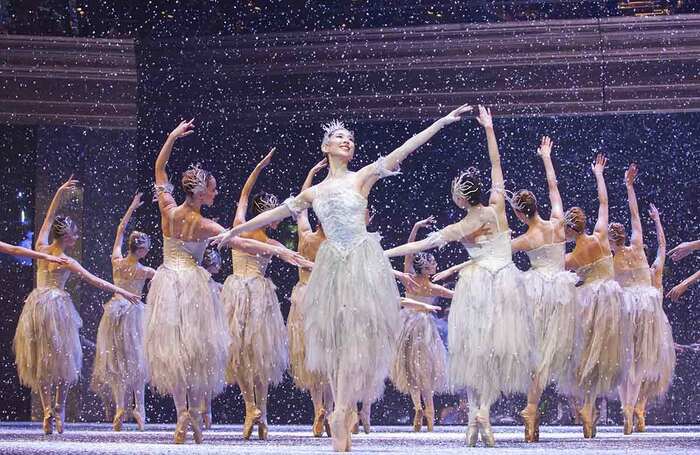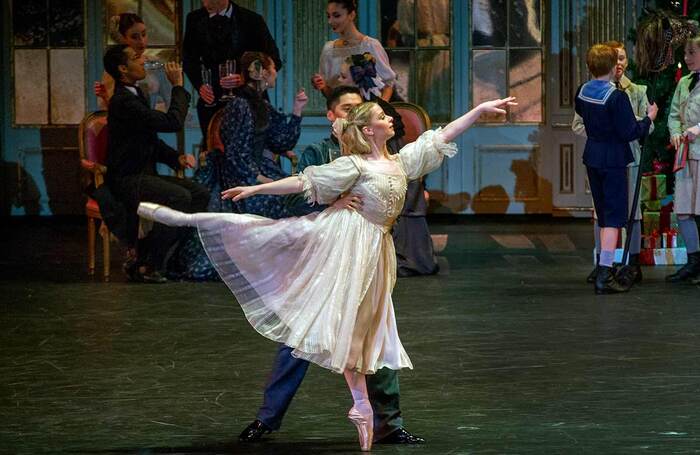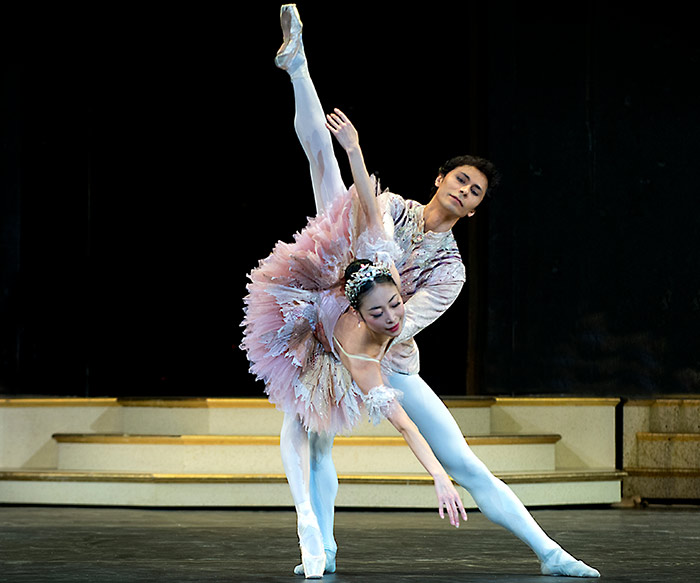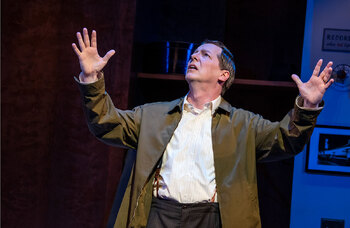Celebrate Christmas with The Nutcracker at Royal Albert Hall
Birmingham Royal Ballet’s spectacular production of The Nutcracker returns to London’s iconic Royal Albert Hall this Christmas. Two of its stars tell the Stage why they love dancing in the timeless classic and what makes this version especially magical
Christmas is not Christmas without The Nutcracker. The timeless ballet – with Tchaikovsky’s classic score – has been a much-loved seasonal staple on stages around the world for more than a century, and has inspired a love of dance in children and adults alike, generation after generation. It is like mulled wine or mince pies or mistletoe: the festive season would not be complete without it.
Few stagings of The Nutcracker can rival Peter Wright’s for Birmingham Royal Ballet, and few venues can rival London’s Royal Albert Hall in which to see it. The acclaimed company first performed its specially adapted version of the ballet at the South Kensington concert hall in 2017, then returned in 2018 and 2019, but the pandemic put paid to subsequent productions.
This winter, though, audiences can finally experience the exhilaration of seeing this magnificent production of this show in such majestic surroundings once again, when Birmingham Royal Ballet returns to the Royal Albert Hall for seven special performances between Christmas and New Year, starting on Wednesday December 28 and running until New Year’s Eve.
“It has become a bit of a tradition for us to do this wonderful show at the Royal Albert Hall every Christmas,” says Momoko Hirata, a principal dancer with the Birmingham Royal Ballet, who will be appearing as the Sugar Plum Fairy for two performances. “I have really missed it for the last two years. It has felt like part of Christmas is missing. It means everything to be back doing it again.”
Mathias Dingman, another principal with the Birmingham Royal Ballet, who will appear as the Prince for two performances at the Royal Albert Hall, agrees. “It is a special, special show,” he says. “To be back doing such a magical ballet on such a grand scale is just brilliant.”
Continues...
What actually happens in The Nutcracker? The story is set on Christmas Eve and starts with the Stahlbaums and their daughter Clara celebrating a festive party with their family and friends. Then, the local magician Drosselmeyer arrives, hands out gifts – including the titular toy to Clara – and things start to get magical. At midnight, the Christmas tree grows gigantic, gingerbread soldiers come to life and wage war against an army of invading mice, and the Nutcracker transforms into a prince and leads Clara into the wonderful land of sweets where the Sugar Plum Fairy reigns.
It is based on the 1816 story by Prussian writer ETA Hoffman called The Nutcracker and the Mouse King, adapted by French writer Alexandre Dumas in 1844. The composer Tchaikovsky and the choreographers Marius Petipa and Lev Ivanov collaborated to stage the very first ballet version in St Petersburg in 1892. By the mid 20th century, it had gone global, with productions by acclaimed choreographers with companies around the world: the New York City Ballet in 1954, the Royal Ballet in 1963 and 1984, the Bolshoi Ballet in 1966, and Birmingham Royal Ballet in 1990.
It is the 1990 version – with choreography by Wright and sets designed by John Macfarlane – that has been performed by Birmingham Royal Ballet ever since, and it is that version that was specially adapted for the Royal Albert Hall by David Bintley in 2017, incorporating Wright’s classic choreography and Macfarlane’s original costumes, but reimagining the set and the show that surrounds them. And it is that version that finally returns to London this Christmas.
Along its journey, from 1892 to 2022, The Nutcracker has inspired countless young boys and girls to take up ballet, including Hirata herself. “Peter Wright’s version of The Nutcracker for Birmingham Royal Ballet was actually the first ballet I ever saw,” she says. “I saw it on VHS when I was a child in Japan. My mum got it from the local library and I fell in love with it. It made me want to be a ballerina, as it did for so many others. And now here I am, decades later, actually dancing in it.”
Continues...
What is it about The Nutcracker that makes it such a special show? Why do artists return to it again and again? Why do audiences visit and revisit it year after year after year?
Well, says Dingman, there are several reasons. Partly, it is the story; Clara’s journey from her family’s joyful Christmas party, through the frenetic battle between the Gingerbread Soldiers and the Mice, into the blissful Land of the Sweets, can’t help but capture the imagination. And partly it is the score that, at the Royal Albert Hall, will be played by the world-renowned Royal Ballet Sinfonia.
“Everybody knows the music and everybody loves it,” Dingman says. “Whether you know it from seeing the ballet, listening to it online or hearing it in an advert, Tchaikovsky’s score will be familiar to you. It is comfortable and it is beautiful. I think that is the real secret to The Nutcracker’s success.”
And what is it that makes Wright’s 1990 staging of The Nutcracker for the Birmingham Royal Ballet so particularly precious to so many, above those versions staged by George Balanchine for the New York City Ballet, by Rudolf Nureyev for the Royal Ballet, and by Yuri Grigorovich for Moscow’s Bolshoi Ballet? For Hirata, it is the way the veteran choreographer imbues the story with hope.
“Peter reinvented the character of Clara as an aspiring ballerina and she becomes one at the end of the second act,” she explains. “I love that idea. It really makes children believe they can succeed at whatever they want to be as well. For me, it is the most beautiful production in the world.”
Continues...
The Royal Albert Hall’s version of The Nutcracker is especially astonishing. It uses Wright’s enchanting 1990 choreography – with a few tweaks to accommodate the size of the Royal Albert Hall stage – and Macfarlane’s acclaimed costumes, but it completely reimagines the surrounding show, utilising a spectacular set from designer Dick Bird, and extravagant, eye-popping projections custom-made by groundbreaking, London-based studio 59 Productions.
“These huge projections go all the way around the theatre,” explains Dingman. “It looks absolutely spectacular. To dance on that stage, with the Royal Ballet Sinfonia playing Tchaikovsky’s glorious music, with those incredible projections surrounding you is just utterly, utterly magical.”
Needless to say, both Hirata and Dingman are desperate to be back on the Royal Albert Hall stage, doing what they love best, and entertaining thousands of audience members over the Christmas period. Both dancers have performed in Birmingham Royal Ballet’s version of The Nutcracker for more than 10 years but they still find Wright’s iconic choreography challenging.
“The Sugar Plum Fairy is one of the most difficult roles to play,” says Hirata. “No matter how many times I do it, it still doesn’t get any easier. You are only on stage for 15 minutes or so, but you have to do one of the hardest solo dances you could imagine, with crystal clear technique and nowhere to hide. I love it, though. I love challenging myself like that.”
Dingman agrees. “In terms of stage time, the Prince in The Nutcracker is not that much dancing,” he says. “In terms of effort, though, it is epically hard. I dance one pas de deux with Clara and one with the Sugar Plum Fairy and, by the end of it, I am just dead. I love that challenge, though. And I still love performing The Nutcracker. Christmas just would not be the same if I didn’t.”
The Nutcracker runs at The Royal Albert Hall from December 28. For tickets, visit royalalberthall.com
Most Read
Across The Stage this weekYour subscription helps ensure our journalism can continue
Invest in The Stage today with a subscription starting at just £5.99











